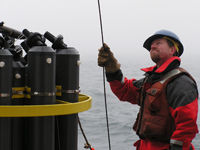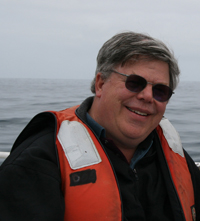International Scientists Find ‘Acidified’ Water on the Continental Shelf from Canada to Mexico
May 22, 2008
Evidence of corrosive water caused by the ocean’s absorption of carbon dioxide (CO2) was found less than 20 miles off the west coast of North America during a field study from Canada to Mexico last summer. This was the first time “acidified” ocean water has been found on the continental shelf of western North America.
The term “ocean acidification” describes the process of ocean water becoming corrosive as a result of carbon dioxide being absorbed from the atmosphere.
“Acidification of the Earth’s ocean water could have far-reaching impacts on the health of our near-shore environment, and on the sustainability of ecosystems that support human populations through nourishment and jobs,” said Richard W. Spinrad, NOAA assistant administrator for oceanic and atmospheric research. “This research is vital to understanding the processes within the ocean, as well as the consequences of a carbon-rich atmosphere.”

Christopher Sabine on a field study in the Southern Ocean aboard the NOAA R/V Ronald H Brown.
High resolution (Credit: NOAA/PMEL)
The findings will be published May 22 in the online journal Science Express. “Evidence for Upwelling of Corrosive ‘Acidified’ Water onto the Continental Shelf” was written by Richard A. Feely and Christopher Sabine, both oceanographers at NOAA’s Pacific Marine Environmental Laboratory in Seattle, Wash. Their co-authors are J. Martin Hernandez-Ayon of the Instituto de Investigaciones Oceanologicas from the University of Baja California, Mexico; Debby Ianson of Fisheries and Oceans Canada in Sidney, British Columbia, and Burke Hales, of Oregon State University College of Oceanic and Atmospheric Sciences, Corvallis, Ore.
“Our findings represent the first evidence that a large section of the North American continental shelf is seasonally impacted by ocean acidification,” said Feely. “This means that ocean acidification may be seriously impacting marine life on our continental shelf right now.”

Richard Feely on a field study last summer aboard the R/V Wacoma.
High resolution (Credit: NOAA/PMEL)
“While this absorption provides a great service to humans by significantly reducing the amount of greenhouse gases in the atmosphere and decreasing the effects of global warming, the change in the ocean chemistry affects marine life, particularly organisms with calcium carbonate shells, such as corals, mussels, mollusks, and small creatures in the early stages of the food chain,” said Feely.
The study was the first in what is planned to be a biennial sequence of observations and studies of carbon along the west coast of North America. The researchers participated in the North American Carbon Program West Coast Cruise on the R/V Wecoma, owned by the National Science Foundation and operated by Oregon State University. The international scientific team plans to continue their studies of ocean acidification in follow up cruises in late 2009.
Previous studies found ocean acidification at deeper depths farther from shore. The researchers said that the movement of the corrosive water appears to happen during the upwhelling season during the spring and summer, when winds bring CO2 -rich water up from depths of about 400-600 feet onto the continental shelf. The water that upwells off of the North American Pacific coast has been away from the surface for about 50 years.
The field study collected samples from Queen Charlotte Sound, Canada, to San Gregorio Baja California Sur, Mexico. The closest they found corrosive water was about four miles off of the northern California coast.
“We did not expect to see this extent of ocean acidification until the middle to the end of the century,” said Sabine. “Because of this effort, we have a baseline for future observations as we continue to study and monitor the relationship of biological and physical processes and their ability to respond to ocean acidification.”
The researchers participated in the North American Carbon Program West Coast Cruise on the R/V Wecoma, owned by the National Science Foundation and operated by Oregon State University. The study was the first in what is planned to be a biennial sequence of observations and studies of the carbon cycle along the west coast of North America.
“We did not expect to see this extent of ocean acidification until the middle to the end of the century,” said Sabine. “Because of this effort, we have a baseline for future observations as we continue to study and monitor the relationship of biological and physical processes and their ability to respond to ocean acidification.”
“When the upwelled water was last at the surface, it was exposed to an atmosphere with much less CO2 than today and future upwelled waters will probably be more acidic than today’s because of increasing atmospheric CO2,” said Hales, a professor of chemical oceanography, who is also funded by NASA.
"We don't know how this will affect species living in the zone below the level of the lowest tides, out to the edge of the continental shelf," said Ianson, an oceanographer. "We do know that organisms like corals or pteropods are affected by water saturated with CO2. The impacts on other species, such as shellfish and other juvenile fish that have economic significance, are not yet fully understood."
“In Baja California, we have several Mediterranean-climate coastal lagoons where the main external physical and biogeochemical forcing is from the neighboring coastal ocean, strongly influenced by upwelling,” said Hernandez-Ayon, a coastal oceanographer. “We are concerned about these areas because they play an important role as nurseries and feeding grounds of juvenile fish populations but are also are ideal sites for shellfish aquaculture.”
The National Oceanic and Atmospheric Administration, an agency of the U.S. Commerce Department, is dedicated to enhancing economic security and national safety through the prediction and research of weather and climate-related events and information service delivery for transportation, and by providing environmental stewardship of our nation's coastal and marine resources. Through the emerging Global Earth Observation System of Systems (GEOSS), NOAA is working with its federal partners, more than 70 countries and the European Commission to develop a global monitoring network that is as integrated as the planet it observes, predicts and protects.